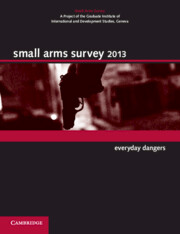Book contents
- Frontmatter
- Foreword
- Contents
- About the Small Arms Survey
- Notes to readers
- Acknowledgements
- Introduction
- Chapter 1 Everyday Dangers: Non-conflict Armed Violence
- Chapter 2 Too Close to Home: Guns and Intimate Partner Violence
- Chapter 3 Turning Points: Gang Evolution in Nicaragua
- Chapter 4 Guns in the Family: Mafia Violence in Italy
- Chapter 5 Survival at Stake: Violent Land Conflict in Africa
- Chapter 6 Trend Lines: Armed Violence in South Africa pages 132 to 137
- Chapter 6 Trend Lines: Armed Violence in South Africa pages 137 to 159
- Chapter 7 Second Wind: The PoA's 2012 Review Conference pages 160 to 168
- Chapter 7 Second Wind: The PoA's 2012 Review Conference pages 169 to 177
- Chapter 8 Trade Update: Authorized Small Arms Transfers
- Chapter 9 Burning the Bullet: Industrial Demilitarization of Ammunition pages 186 to 199
- Chapter 9 Burning the Bullet: Industrial Demilitarization of Ammunition pages 200 to 217
- Chapter 10 ‘Infernal Machines’: Improvised Explosive Devices
- Chapter 11 Price Watch: Arms and Ammunition at Illicit Markets pages 250 to 268
- Chapter 11 Price Watch: Arms and Ammunition at Illicit Markets pages 269 to 281
- Chapter 12 Captured and Counted: Illicit Weapons in Mexico and the Philippines pages 282 to 302
- Chapter 12 Captured and Counted: Illicit Weapons in Mexico and the Philippines pages 302 to 317
- Index
Chapter 6 - Trend Lines: Armed Violence in South Africa pages 132 to 137
Published online by Cambridge University Press: 05 June 2014
- Frontmatter
- Foreword
- Contents
- About the Small Arms Survey
- Notes to readers
- Acknowledgements
- Introduction
- Chapter 1 Everyday Dangers: Non-conflict Armed Violence
- Chapter 2 Too Close to Home: Guns and Intimate Partner Violence
- Chapter 3 Turning Points: Gang Evolution in Nicaragua
- Chapter 4 Guns in the Family: Mafia Violence in Italy
- Chapter 5 Survival at Stake: Violent Land Conflict in Africa
- Chapter 6 Trend Lines: Armed Violence in South Africa pages 132 to 137
- Chapter 6 Trend Lines: Armed Violence in South Africa pages 137 to 159
- Chapter 7 Second Wind: The PoA's 2012 Review Conference pages 160 to 168
- Chapter 7 Second Wind: The PoA's 2012 Review Conference pages 169 to 177
- Chapter 8 Trade Update: Authorized Small Arms Transfers
- Chapter 9 Burning the Bullet: Industrial Demilitarization of Ammunition pages 186 to 199
- Chapter 9 Burning the Bullet: Industrial Demilitarization of Ammunition pages 200 to 217
- Chapter 10 ‘Infernal Machines’: Improvised Explosive Devices
- Chapter 11 Price Watch: Arms and Ammunition at Illicit Markets pages 250 to 268
- Chapter 11 Price Watch: Arms and Ammunition at Illicit Markets pages 269 to 281
- Chapter 12 Captured and Counted: Illicit Weapons in Mexico and the Philippines pages 282 to 302
- Chapter 12 Captured and Counted: Illicit Weapons in Mexico and the Philippines pages 302 to 317
- Index
Summary
INTRODUCTION
On 27 April 1994 the first democratic elections were held in South Africa, marking the country's official transition from more than 300 years of authoritarianism and institutionalized racism to a free and democratic society. In the 19 years since, the country has made progress in improving rule of law, governance, and public health. South Africa now ranks well above its neighbours in sub-Saharan Africa in economic and human development indicators (UNDP, 2011). Yet, despite localized economic growth, South Africa experiences persistently high levels of unemployment (an average of 25 per cent in 2000–12), income inequality, systemic corruption, and unequal economic and social transformation. These challenges are so severe that they risk undoing recent gains.
Similarly, South Africa's health outcomes remain much lower than those of other middle-income countries that are not at war—in fact, lower than in many poorer countries (Coovadia et al., 2009, p. 817). The nation continues to struggle with high levels of armed violence, with a homicide rate about four times the global average—among the world's highest (Geneva Declaration Secretariat, 2011, pp. 51–53). Research suggests that persistently high levels of armed violence and underperformance in health and development are related (Bellis et al., 2010; OECD, 2009; Geneva Declaration Secretariat, 2008). South Africa appears to be a case in point.
This chapter explores South Africa's dilemma, namely that its incremental progress and growth are undermined by ongoing and systemic armed violence and inequality.
- Type
- Chapter
- Information
- Small Arms Survey 2013Everyday Dangers, pp. 132 - 137Publisher: Cambridge University PressPrint publication year: 2013



